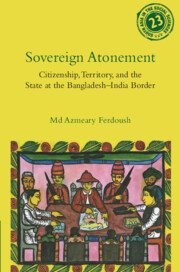Book contents
- Frontmatter
- Contents
- List of figures
- Preface
- Acknowledgments
- Introduction: Remnants, nations, and the sovereign
- 1 Sovereign atonement
- 2 From “sensitive” to “symbolic” spaces
- 3 Land and citizenship as technologies of territory
- 4 Everyday governance: Ambiguity, accountability, and abundance
- 5 Infrastructure, belonging, and the state
- 6 Refusal and tolerance
- Epilogue
- Appendix: A note on methods
- References
- Index
Introduction: Remnants, nations, and the sovereign
Published online by Cambridge University Press: 30 April 2024
- Frontmatter
- Contents
- List of figures
- Preface
- Acknowledgments
- Introduction: Remnants, nations, and the sovereign
- 1 Sovereign atonement
- 2 From “sensitive” to “symbolic” spaces
- 3 Land and citizenship as technologies of territory
- 4 Everyday governance: Ambiguity, accountability, and abundance
- 5 Infrastructure, belonging, and the state
- 6 Refusal and tolerance
- Epilogue
- Appendix: A note on methods
- References
- Index
Summary
On the night of September 28, 2014, Selina, an expectant young woman and a mother of two, was brutally murdered in front of her six-year-old son by four men, one of whom was later found to be her husband. While her neighbors discovered the deceased woman the next morning and informed the authorities of it immediately, her lifeless body remained on the crime scene for the next two days (Daily Ittefaq, 2014). Selina was a resident of India's Islampur enclave inside Bangladesh. Since she was an Indian enclave dweller, neither the crime scene nor Selina's body was under the official jurisdiction of the state of Bangladesh. Furthermore, the unique territorial oddities of the enclave prevented the Indian police from intervening, because the enclave was inside Bangladesh, another sovereign state, where the Indian police lacked authority. For the Indian police to have entered Bangladesh in an official capacity, they would have required complicated bureaucratic arrangements. Local residents and political figures pressed the Bangladesh police to consider it from a “humanitarian perspective.” Only then was Selina's body taken and preserved in a morgue in the Bangladeshi district of Lalmonirhat. After several meetings, concerned authorities across borders – that is, the Bangladeshi police, the Indian police, and the respective border security forces, the Border Guard Bangladesh (BGB) and Border Security Force (BSF) of India – arranged for a team of Indian police to investigate the crime scene inside Bangladesh. Selina's body was taken to India for an autopsy. It took eighteen days for Selina's body to be handed back to her family and friends for her funeral.
Only a few years later, the situation for the residents of the enclaves was significantly transformed. In another former Indian enclave of Dasiar Chhara, located inside Kurigram district of Bangladesh, I met Nuruddin1 during my ethnographic fieldwork in 2017. Dasiar Chhara was then merged with regular Bangladeshi territories and was undergoing numerous state-making processes as part of a successful territorial swap between India and Bangladesh. I was taking a walk and having a casual chat with Nuruddin, a twenty-seven-year-old man, who was enthusiastically showing me how things had changed in Dasiar Chhara after it officially became part of Bangladesh.
- Type
- Chapter
- Information
- Sovereign AtonementCitizenship, Territory, and the State at the Bangladesh-India Border, pp. 1 - 26Publisher: Cambridge University PressPrint publication year: 2024

